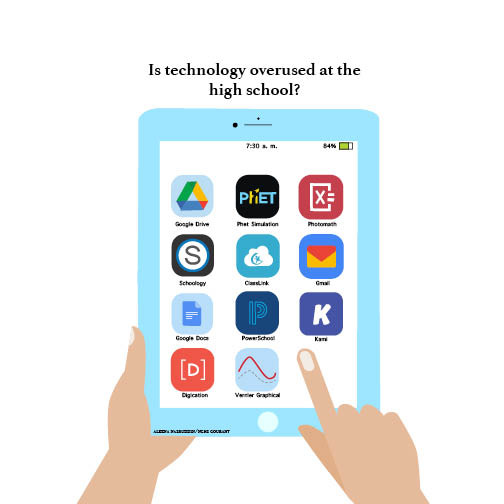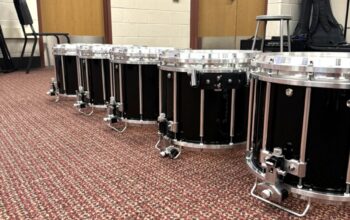Aleena Nasruddin, Editor-in-Chief
@aleenacourant
This year the high school added two new technology implementations: ClassLink and student ID scanners. ClassLink is a platform that provides a single sign-on access to all online platforms the high school uses. ID scanners are used by teachers to check students out of the school during free periods, check students into study halls at the library, and purchase food in the cafeteria. While the high school has implemented technology with the purpose of increasing efficiency, these new implementations beg the question: is technology overused at the high school?
Technology Integrator Emily Hernberg sees students using technology to build creative projects in the future, rather than solely relying on technology as a form of communication with teachers. “The trajectory toward technology is going to continue. But the way we use technology will change,” she said. “We are bringing back the podcasting studio and we are starting a new VR room now that cleaning protocols have eased for students to start using more hands-on technology as well.”
Ms. Hernberg also hopes that teaching students how to use technology will help them build key skills in technological literacy in the future. “The technology that you use as a freshman here will probably not be the same as the technology you use as a senior in college. Learning how to use Schoology isn’t the long-term goal,” she said. “I care about whether you know how to ask for help with technology, if you know how to change your password, clean up your browser, and access troubleshooting documents.”
That being said, Ms. Hernberg believes that technology should not replace handwritten assignments completely. “There is something to be said about doing hand-written notes. It makes you slow down and think about what you are writing,” she said. “There is real power to bringing your own device to school, but it is also important to bring a notebook and a writing utensil in order to extend your learning.”
Library Department Chair Michelle Luhtala said bringing technology into the library can help students access educational resources. She hopes the digital library, an online Google Meet room which students can enter at any time through the library’s website, will become more known among students as a potential resource for research questions. “The idea is that a kid can hop on the digital library while they are in class, without having to physically come into the library,” she said. “It should be a virtual resource for kids who are on the third floor who have a quick question and want to get it answered by the library.”
Ms. Luhtala said that in addition to spreading educational resources, technology can help students collaborate with each other and with teachers. “Technology when used correctly provides an opportunity to transform and redefine learning. What does Google Docs offer that a paper document doesn’t it? Collaboration. That’s transformative. The ability to literally provide feedback in real-time,” she said. “That is the difference that technology can provide when used right. But again, it is important to always remember that we have options.”
Ms. Luhtala believes technology is now a choice for teachers or students to use at the high school, rather than the only option. “Being forced into it is different than choosing it,” she said. “People are eager to get back into hands-on, shoulder to shoulder, collaborative learning. We can start using the MakerSpace again and doing kinesthetic activities instead of using technology. It’s important to reintroduce choice about digital learning to students and teachers. Last year, we were forced into technology.”
Senior Eve Johansson thinks there are benefits to doing work using technology, such as an online extension called Kami. Kami is used to facilitate writing on PDFs digitally and them in online. “If I am annotating a small document, Kami is useful. But I enjoy annotating larger documents on pen and paper because I understand things better,” she said. “It is easier to flip through and skim paper documents.”
Eve also enjoys the efficiency ClassLink and ID scanners provide, since she spends less time searching for passwords or remembering her PIN code. “I like how much technology we use. It can be a lot and make my eyes hurt sometimes, but I do think we use technology to make things more efficient and faster,” she said.
Even though ClassLink was implemented with the goal of enhancing student learning, senior Elodie Koo said that she does not use ClassLink because it is hard to access school platforms to begin with. “I haven’t really used ClassLink much because, even though it should be one place where you can access everything, it is not much of a hassle to type in the first two letters of your username and password on Schoology or Gmail,” Elodie said. “I think it is nice, but it is not something that I would die without. I like the use of technology, but I think ClassLink is excessive.”
Elodie still thinks technology has become an inevitable part of our lives after the pandemic, and upperclassmen have learned to use technology to their advantage. “Especially for students who have been through the pandemic, it has been easier because we are learning how to use technology alongside administrators,” she said. “I think for later generations, they could use some more guidance on how to use technology since education relies on it heavily now.”
Ms. Hernberg said that our dependence on technology was an inevitable occurrence after the pandemic, but it is our choice on how we go forward using technology at our school. “Last year was a very weird year where we had to use technology to the extent that we did,” Ms. Hernberg said. “I’m hoping that once the pandemic is a distant memory at some point in the future, we can really start to think again about whether or not technology is enhancing student experience or replacing what we were doing before.”




